The Future Of Biohacking In The Age Of Patent Trolls
by Cat Ferguson
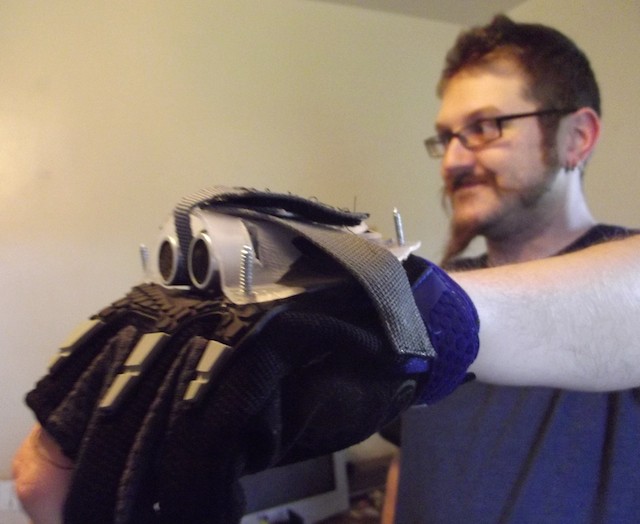
The Bottlenose, a prototype by Grindhouse Wetware, receives sonar, UV, wi-fi and thermal information and translates it to a magnetic field.
We stand at a strange moment in human history, when lawyers and corporations wage war amongst each other over one question: who owns your body? Off to the side, biohackers — the freaks, geeks, rebels, and punks who do biotechnology experiments in garages and basements — must decide whether to abide by the outcomes.
Maybe you’ve heard about this argument in the context of the Myriad Genetics Supreme Court case; that corporation had patented a part of the natural human genome, the “breast cancer gene.” Some versions of the gene make you more likely to get breast and ovarian cancer. Because Myriad figured out the risk associations, they filed a patent… on the gene itself. In every human. If you checked to see which version of the gene you had, you had to pay them a licensing fee. The court unanimously agreed that Myriad can’t own some part of our genetic heritage, just because they “discovered” it. It’s all very Christopher Columbus (or Eddie Izzard).
In 2012, the court heard another case that may have more immediate ramifications for the average person in a doctor’s office. In Mayo v. Prometheus, a company claimed it owned the rights for you to check how their drug affected your natural metabolite levels and then adjust your dosage accordingly. It wasn’t a special diagnostic test, and doctors already knew how to measure the chemicals in your blood. The question was whether knowing to adjust your dose was patentable. The Supreme Court — also unanimously — nixed the patent.
These decisions threw the world of biomedical patents into chaos. There are likely hundreds of patents affected, but it’s incredibly difficult to figure out which ones. Robert Cook-Deegan is the director of the Institute of Genome Ethics, Law, and Policy at Duke University. “I was just talking to a bunch of patent lawyers, and almost all of them were quite certain what the patent law is, but they don’t agree what it is,” he said, during a conversation about the Myriad and Prometheus cases. “You’ll have one patent lawyer say, this is totally valid. And another patent lawyer will say, no no no, this is invalid. And they’ll have very good case law rationales for why they believe what they believe, and they’re very sure of it.”
These questions are ridiculous to me. How can a company own pieces of my body? And how are they going to track down what I’m doing with it? A company owning humans has ramifications outside the medical realm, especially if — as many experts and excellent science fiction authors claim — our future shines bright with deep knowledge of biology and how to drastically alter it.
Some want that editing process sooner rather than later, and most of them want it in the hands of The People. Biohackers, biopunks, grinders, and DIY biologists have the tangled etymological web that many small but passionate groups of ideologues develop. Let’s call them biohackers for now, because it’s basically encompassing and fun to type. As the name suggests, they are to biotechnology what Hackers 1.0 are to software companies.
The parallels go deeper than naming. When computing began, it was at enormous expense, with the backing of governments, corporations, and universities. Computers were the size of buildings and required experts to use and maintain. Once the technology became pint-sized, people like Steve Wozniak and Bill Gates could fit it in their garages and build a revolution. Companies started making their source code more and more private, while hackers were chopping things up and gluing them together for fun and chaos. Richard Stallman and a few others decided technology was for the people, and pioneered a variety of ways to keep that a possibility. Since then, corporate computer culture and free software/hacker culture have co-existed, entangled but separate, swapping ideas and people like bacteria pass plasmids. And in the middle, technology giants beat on each other for the rights to everything from rounded edges on icons to rectangular phones.
Genetic engineering is also an expensive, unwieldy child of private and public funding. It started off requiring thousands of hours and millions of dollars to do the simplest experiments. With whiplash speed, it’s become something hobbyists can do in their garages — or in the hackerspaces that have rearranged the furniture to make room for community labs.
One subset of biohackers call themselves grinders. They are a group of people turning themselves, slowly but surely, into cyborgs. It was born out of biohack.me, a forum for people wanting live longer, stronger lives through DIY body modifications. For many, the first taste of grinding is inserting a magnet into the tip of their finger, which allows them to feel electromagnetic waves around them — imagine turning a microwave on and physically feeling it, or walking over a manhole cover and feeling the power lines beneath. For legal reasons, grinders can’t use anesthetic for their modifications, and rely on body modification experts to slice open their finger tip, push the flesh around to make a pocket, and slide in a magnet before whipping in a few stitches.
While many individuals undertake these experiments on their own, supported virtually by the biohack.me community, Grindhouse Wetware in Pittsburgh is one of the physical homes of the movement. Grinders tend to bristle at the idea of taking biohacking concepts out of the public domain, and believe firmly in open-source technology.
“Biohacking is so intimate. After a while, people’s language changes. They stop saying ‘my magnet’ and start saying ‘my finger,’” said Lucas Dimoveo, a Grindhouse member. “If you start allowing people to have patents in this field, you’re essentially allowing them to patent part of your body. That’s frightening and unethical.”
Others are taking it farther than a finger magnet. In November, another member of Grindhouse, Tim Cannon, had someone cut his arm open and wedge in a box the size of a deck of cards.
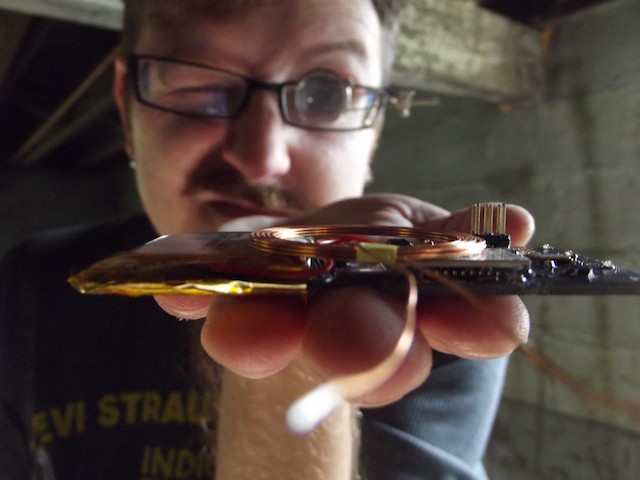
Photo by Grindhouse Wetware.
He used ice for the pain. The device is largely a proof of concept, able to connect to a cellphone via Bluetooth and monitor his temperature. “When we developed it, we wanted to do something super-complex that would explode everyone’s head out of awesome. But we went with the most feature-light thing we could for the first run. It’s easier to test, and we really don’t want to kill our friend Tim,” said Dimoveo. (When I asked how important safety was, he responded, “I guess it’s safety second. Expanding human experience is first, but safety is up there.”)
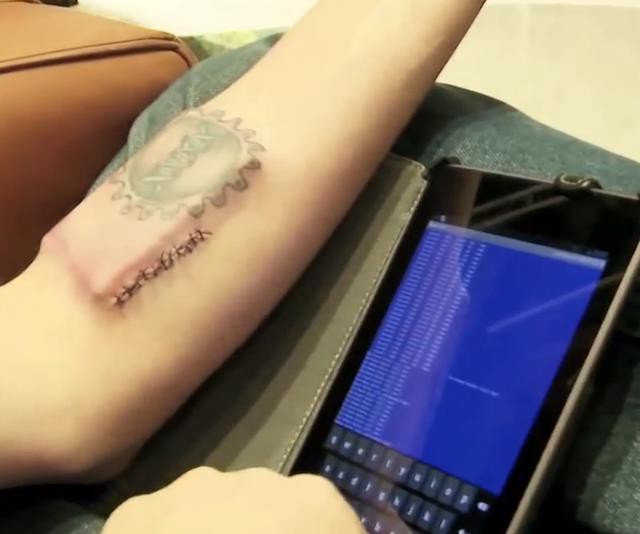
A still from this documentary, which features Tim Cannon.
Rich Lee is another DIY cyborg. Because he will soon be legally blind, he decided to made himself an echolocator, identifying nearby objects in the same way bats and dolphins do. So he stuck an earbud into his ear. Under his skin.
The principle of a speaker is fairly simple: a coil vibrates, which vibrates a magnet, which creates sound. Lee had a body modification artist insert a tiny magnet on the outside of his tragus. He wears a coil necklace that vibrates to create sound in his ear. He can listen to music, and is mulling over other uses, such as the aforementioned echolocation, an in-ear GPS, and a secret directional mic to let him listen to far-off conversations. Oh, the miracles of technology.
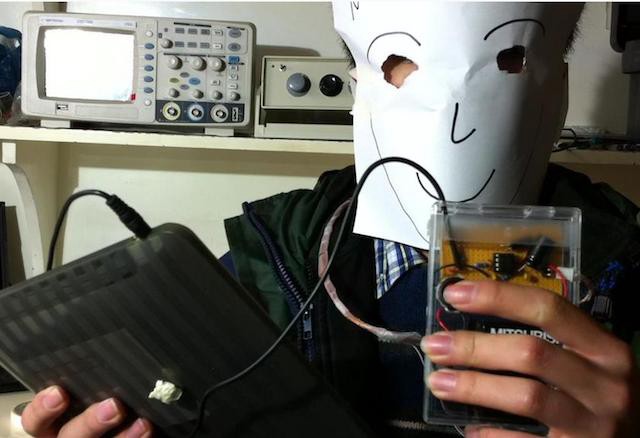
From the Instructable Make Your Own Invisible Earphones; magnet implant demonstrated here.
I emailed Lee to get his opinion on intellectual property protection options. I wasn’t surprised by his response, given the bio he uses on blog posts: “Rich Lee is a Space Gangster, businessman, Grinder, and black hat transhumanist; he promotes tech piracy, biohacking, and committing Grand Theft Future.”
He wrote:
Our legal system looks at things in the context of legal precedence, pouring through thousands of laws and case laws to figure out what laws should apply in these ip disputes. They will never convince me that I have a duty not to buy $30 in supplies to pirate a gene therapy in my garage to save a family member from a fatal condition. They can’t convince me that it is unpatriotic or immoral to use my own materials to make myself a lovetron9000 which borrows from engineering concepts found in their ip (which borrowed from other ip, which took from other ip, etc). So I view these decisions as cute little edicts, even when the ruling might be to my own liking. There is no future for ip law.
Other biohackers are more focused on microscopic life than grinders are. Mac Cowell is one of the founders of DIYBio, a loosely connected group of community labs around the world. They generally focus on cell biology — engineering yogurt cultures, making bacteria glow green. Cowell (who drove me around San Francisco on his scooter and bought me a Bloody Mary) doesn’t have more than a passing ideological complaint against patents as a concept, but he certainly isn’t content with the current state of things.
“Really specific patents that are very narrow in scope are great. Like, sure, invent something, get protected in this very narrow way. When it becomes a problem is when the patent office grants patents that are so fucking wide, you don’t even know if you’re violating them. Like, you’re probably violating a patent right now, and you don’t even know it!” Cowell gestured towards my LiveScribe, which records as I write. “You’re writing with your pen, do you have a license for that?”
I hesitated. “I… bought it?”
“No one’s enforcing it, but you probably are,” he said.

Garages and hackerspaces aren’t the only places individuals must make decisions about whether they’ll respect biotech patents. There’s an international competition called iGEM, or International Genetically Engineered Machine. College students (and, for the first time next year, biohackers) have access to the BioBricks library, a repository of standard biological parts. It’s a little like Legos, but with more pipetting. The goal is to make a bacteria do something cool or useful that it didn’t do before.
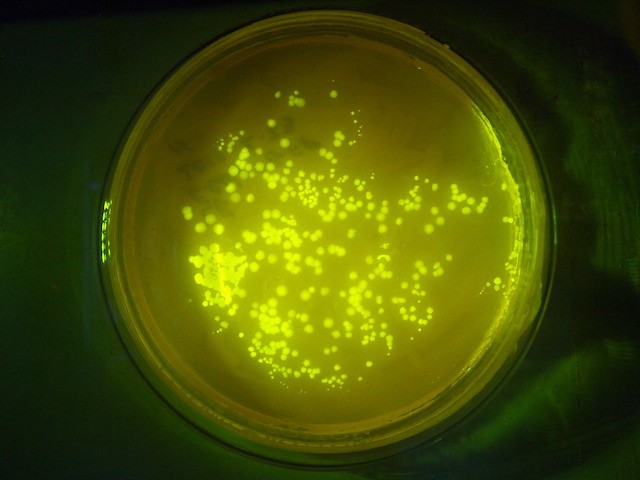
BOSSLAB’s “Bluegene” project synthesizes indigo with bacteria. Photo by Avery Louis.
Patents don’t come into play much at the university level, because no company wants to sue a bunch of starry-eyed 19-year-olds. But once students — or biohackers — have a useful product in hand, they might want to sell it. “That’s a really steep learning curve, the university to industry transition. To make money you have to be able to practice your invention, and make sure you don’t infringe on the rights of others,” said Linda Kahl, the legal director of the BioBricks Foundation.
To make sure they’re not infringing, they’re going to need to pay a patent lawyer tens of thousands of dollars to research the “patent landscape” — who has what patents, and what are even valid. But, of course, no one knows.
“When you get that letter from the lawyer, keep it!” said Kahl. If you can prove you tried not to violate a patent (“good faith”) you’ll be on the hook for a third of what you’d pay if you looked into it, realized you were violating a patent, and sold your product anyway. Willful infringement is triple damages.
On the other hand, Cook-Deegan told me, some lawyers advise against looking at the landscape. If there’s a paper-trail showing that you looked and realized there was already a patent in your way, you’re on the hook for… triple damages.
“Where the existence of a patent comes into play is when money is involved. There’s no reason to sue students, because there’s no money in it and it would do reputational damage,” Kahl told me.
If patent holders decide to sue people using their intellectual property without a license, “it’s really expensive — it’s a million dollar end game. Most people would rather pay 10 or 20 or even 100,000 dollars to make this thing go away,” Cook-Deegan said. There are a number of shell or holding companies — some linked to enormous corporations with names that rhyme with Bapple and Oogle — that collect and enforce patents, which is a lucrative venture. (Of course, everyone’s a potential victim in this game.) In an interesting twist, this week, Google’s former head of patents and patent strategy became the interim director of the United States Patent and Trademark Office.
Cook-Deegan refers to them as patent trolls — “I’m using the pejorative term deliberately.” “We don’t have many examples in biotech, but everyone’s a little afraid it’s going to get bigger as the money gets bigger,” he said.
Some people are determined to forge ahead, making the necessary evil of patents work for them. GETit, the Gonorrhea Eradication Team and Integration Task-Force, is a small group based in Oakland with an admirable goal: applying an interesting and under-utilized therapy to treat drug-resistant bacteria.
Phage therapy involves finding useful viruses that target and destroy only very specific bacteria. The ultimate goal is to send them after the pathogen in question. (Did the word ‘virus’ scare you? Then you probably don’t want to know that phages are already in commercial use. In 2006, the FDA approved ListShield, a spray filled with phages against various strains of listeria, a seriously unpleasant food poisoning bug. Thanks for keeping me diarrhea-free, viruses.)
Drug companies generally won’t touch phages with a ten foot pole, for a few reasons. First of all, there’s a low success rate. Another reason is regulatory — you’d probably need a bunch of different phages in one injection, and the FDA generally rejects that kind of cocktail therapy. The most relevant reason for our purposes here is patent law. After the Myriad decision, can something isolated from nature — the phages — be patented? Who knows! Drug companies aren’t going to throw away millions on such a risky bet.
But biohackers don’t need millions of dollars, theoretically. And if they engineer it in some way, create a novel method of isolating the phages, or otherwise made something patentable, what comes next is up to them.
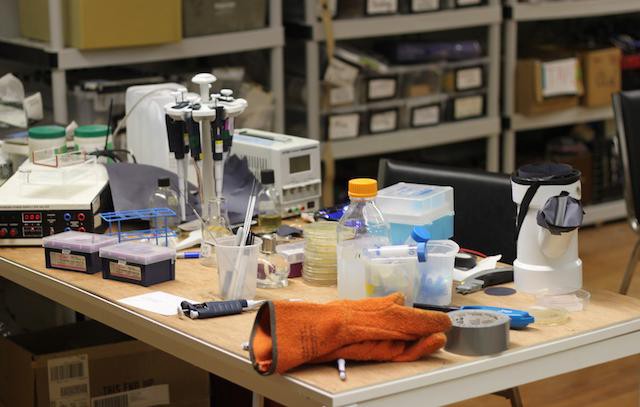
The BOSSLAB’s lab in Boston. Photo by Avery Louis.
GETit’s solution is to “defensively patent” any creations — that is, patent it before anyone else grabs it and makes it proprietary. “Our real goal is keeping it as decentralized and community-focused as possible,” said Craig Rouskey, one of GETit’s founders. “All the intellectual property will be owned by a non-profit, and decisions will be based on 100% consensus. If the community wants to sell the IP, which is very unlikely given the people we’re working with” — we both laughed, since it’s tough to imagine the group selling anything to big pharmaceutical companies — “it would be decided by everyone.”
“This keeps it open for citizen scientists to continue their research on it. The idea is that, after this original round of research, they would be able to develop them into therapies,” Rouskey said. “By decentralizing it, there will be better access to therapy. Amy in Chicago will find different phages than we will in the Bay Area.”
Most biohackers are too busy messing around with life to worry about who legally owns what. When I first asked Cowell what he thought about patents, he threw his arms up like he was playing toss-and-catch with an invisible toddler. “To hell with IP, let’s just figure it out. It’s not like I’m not going to write a computer program because I’m afraid it might violate IP somewhere. I’m not going to call my lawyer up and say, ‘Yo, here’s a thousand dollars, I wrote some methods statements, can you just look around for me?’”
